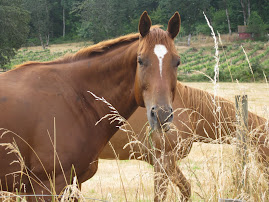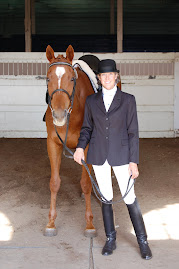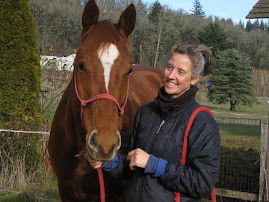(I may have to double check my spelling...)
The Hamstrings are, of course, the muscles of the hindquarters that run down the back side of the horse's legs and attach into the achilles tendon and to the calcaneus (the bony protrusion of the hock).
The Hamstrings are known as: "The Semi Brothers."
They are the muscles used when you get KICKED.
Ouch.
These are VERY STRONG MUSCLES.
Why are these muscles important to riding????
The Hamstrings help create the SWING (freedom) and the SUSPENSION (push) in your horse's stride. Therefore, they need the ability to FLEX. The range of motion in these muscles should be similar to the range of motion in your Long Back muscle (remember the name??).
When the hamstrings flex correctly and push the stride forward, it is similar to doing squats.
Go. Do some squats. (When horses do squats, they're called piaffes!!)
Now do squats and move forward. Focus on HOW your hamstrings feel. Are they flexible? How deep can you sit on one leg before you have to release it and push yourself onto the other leg. How much SUSPENSION can you create with your own hamstrings? Do ya feel the burn!?!?!?
Transfer this movment to your horse's backside. What do you want to feel????
When your horse is using his/her hamstrings well, there is freedom in the gait and the hindlegs can "track-up." The gait is loose and swinging (because his/her back is moving, too!) and, most importantly, the gait is comfortable. Hamstrings that are inflexible create a very bouncy trot - one that throws you out of the saddle, but does not allow you sit back down into the gait - more "pogo-sticking" - because the horse cannot sit back down into his/her OWN gait.
With the give and take in the hamstrings, your horse can absorb the movement and then send it forward to the next stride creating a "bouncing ball" rhythm that you can ride and ride...and ride...and...ride.....
Here are some things to do when you horse is having sticky issues in his/her hamstrings:
1) Transitions. Get the answer and worry about PRETTY later. Get your transition when YOU want them and your horse's self-carriage will improve, therefore, his/her overall position.
2) Backing. After a warm-up of FORWARD! Halt your horse momentarily and ask for the back WITHOUT USING YOUR REINS. Give the cue from your body and don't let your horse talk you into using the reins. This gives him/her an out if he/she gets tense. Be wise, however, if your horse is offering to rear - be safe instead of sorry - move forward out of the back and try again.
3) Baby Walk Pirouette. I call them "baby" because they are BIG. Make sure as you turn into your pirouette, that your horse continues to move forward AND his/her hindlegs keep moving. If your horse happens to get "stuck," GO FORWARD. Try your baby walk pirouette on the next turn.
4)"Western Pleasure" jog. I'm not trying to piss anybody off here. A correct & true "jog" is one off the horse's butt and topline. Asking for a slow, deep flexing jog does just that - flexes the hamstrings deeper and slower then a forward, swinging trot. It is a great lunge line exercise to help free up the hinquarter and the back.
Next Blog: The complimentary muscles that help the hamstring.
Subscribe to:
Post Comments (Atom)




No comments:
Post a Comment